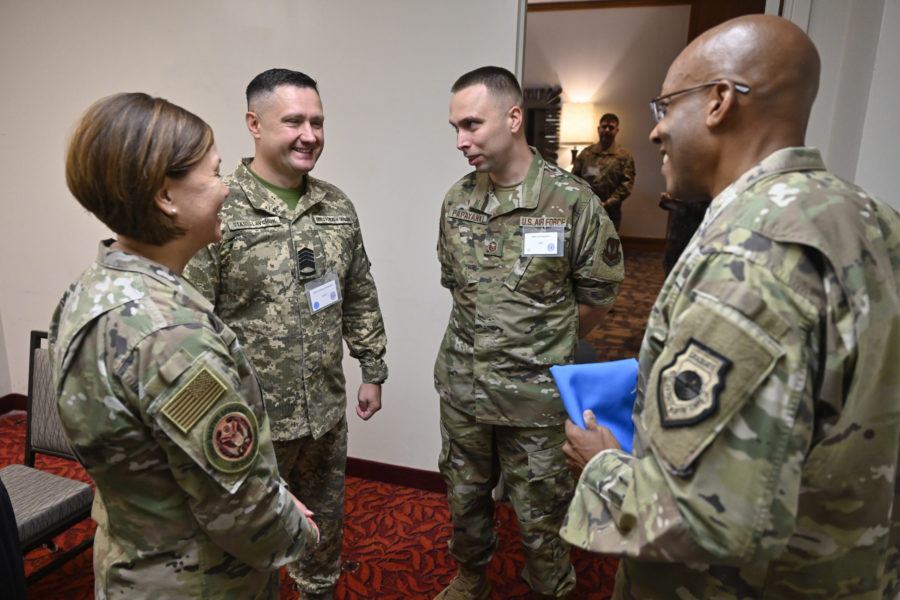Russia’s long-range bombers fire cruise missiles against Ukrainian civilian and military infrastructure nearly unimpeded, so Ukraine needs surface-to-air missile systems that can track and destroy cruise missiles, a senior Ukrainian defense official told Air Force Magazine.
Russian TU-160 and TU-135 strategic bombers take off in Russian airspace, off-limits territory for attack with the U.S.-supplied weapons that Ukraine now operates. Once airborne, they launch deadly cruise missiles capable of hitting targets across Ukraine. Then the bombers safely land, having never been in danger.
The destruction has been relentless. Civilian apartment buildings, recreation centers, shopping malls, and port facilities. Russia alleges to have also hit Ukrainian weapons depots.
Ukraine’s network of surface-to-air missile systems has helped. The Norwegian-built National Advanced Surface-to-Air Missile System (NASAMS), which is also used to protect Washington, D.C., will be an added advantage. But two systems announced by President Joe Biden on July 1 and under contract by the U.S. government for Ukraine are believed to be months away from delivery.
A Ukrainian Defense Ministry official told Air Force Magazine they are hoping the NASAMS will arrive by mid-September.
“We need specific systems that can track and shoot down cruise missiles,” Chief Master Sergeant of the Ukrainian Air Force Kostiantyn Stanislavchuk told Air Force Magazine on the sidelines of the Senior Enlisted Leader International Summit near Washington, D.C.
Stanislavchuk was on hand to tell NCO leaders from more than 60 countries how Ukraine’s NCO corps has been able to push back Russia thanks to U.S. and NATO standard training.
Still, the enlisted chief said there are limits to what Ukrainian forces can do against superior Russian aircraft and sophisticated cruise missiles.
“In the current air picture, we’re seeing the Ukrainian Air Force is dominant in the areas that they are controlling right now,” he said. “The Russians are not even getting close to actually pushing through it. They can’t because there’s too much defense, there’s too much coverage on that area.”
Stanislavchuk said he wanted to see all of Ukraine protected by the Ukrainian Air Force. He told a story from the early days of the conflict to demonstrate the will of Ukraine’s pilots.
Four Russian fighters were observed approaching Kyiv.
The Ukrainian Air Force launched two MiG-29s to intercept the aircraft. When the two pilots got airborne, they saw 12 Russian aircraft flying from four points.
“In air battles, we were significantly outnumbered by the enemy,” Stanislavchuk recounted to the NCO group Aug. 1.
“Two of our pilots did not deviate from the course and went straight to the enemy,” he said. “As a result of the dogfight, we lost one pilot who was killed, while the other pilot completed the mission and returned to base. The invaders lost three of their planes.”
Stanislavchuk said the Ukraine Air Force’s other main gap, in addition to SAMs that can shoot down cruise missiles, is modern aircraft. Ukraine now flies Soviet-era MiG-29s and Su-24s.
“With cruise missiles, it is more difficult for our air defense. Our only system of air defense of the state is no means of anti-missile defense,” he told the group, saying Ukraine’s air defenses are no comparison with the U.S.-made Patriot missile batteries operated by Poland and Romania.
“We only have anti-aircraft defense equipment,” he explained. “In addition to aircraft, we also shoot down cruise missiles, although this is a difficult target.”
Stanislavchuk said the Russian strategic bombers are launching their missiles while flying over the waters of the Black Sea, from inside Russia, and from the Caspian Sea in particular.
He added that new fighter aircraft could be quickly employed and used with great efficiency, similarly to how Javelin anti-tank missiles had helped destroy more than 1,700 tanks and more than 4,000 armed combat vehicles as of Aug. 2.
Still, Russia is believed to have fired more than 3,000 missiles, ballistic and cruise, at Ukraine since the conflict began Feb. 24.
“We were utilizing javelins so accurately, so efficiently, it was just destroying the enemy left and right,” he said.
“Just getting the planes is going to be filling a huge part of the efforts that we need right now,” Stanislavchuk said. “We can just destroy them right there on the spot and keep pushing them further and further. Overall, it’s going to provide us a huge superiority in the air.”
Stanislavchuk said the Ukrainian military has demonstrated its motivation to quickly train and effectively use the weapons provided by other nations.
“With the modern planes, they will be utilized immediately. We will train up our pilots as quickly as possible to hit and control the airspace,” he said. Ukrainian Air Force officials have said they can train 30 available pilots on the F-16 in six months’ time.
Efforts to pass U.S. legislation that would fund the training of Ukrainian pilots has stalled, and the Pentagon has said the focuses of air support to Ukraine right now are unmanned aerial systems and High Mobility Artillery Rocket System (HIMARS). The U.S. has already committed 16 HIMARS systems to Ukraine, and 12 are known to be in use.
“As soon as we get the planes in the air, we start destroying airplanes as quickly as possible and as efficiently,” Stanislavchuk said of the prospect of receiving modern aircraft—“just because there’s just the motivation and the spirit to fight and destroy.”

